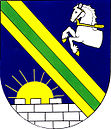Raná u Hlinska
| Raná | ||||
|---|---|---|---|---|
|
||||
| Basic data | ||||
| State : |
|
|||
| Region : | Pardubický kraj | |||
| District : | Chrudim | |||
| Area : | 704 ha | |||
| Geographic location : | 49 ° 48 ' N , 15 ° 58' E | |||
| Height: | 485 m nm | |||
| Residents : | 368 (Jan 1, 2019) | |||
| Postal code : | 539 01 - 539 72 | |||
| License plate : | E. | |||
| traffic | ||||
| Street: | Holetín - Předhradí | |||
| Railway connection: | Havlíčkův Brod – Pardubice | |||
| structure | ||||
| Status: | local community | |||
| Districts: | 3 | |||
| administration | ||||
| Mayor : | Vladimír Hubený (as of 2018) | |||
| Address: | Raná 16 539 72 Raná u Hlinska |
|||
| Municipality number: | 572152 | |||
| Website : | www.obecrana.cz | |||
Raná (German Ranna ) is a municipality in the Czech Republic . It is located six kilometers northeast of Hlinsko and belongs to the Okres Chrudim .
geography
Raná is located in the valley of the Raná stream ( Black Stream ) north of the Saar Mountains and southeast of the Eisengebirge . With Vojtěchov located above , where the train station is located, Raná forms a coherent settlement area in the Raná valley. The Čertovina (652 m nm) rises to the south, the Medkovy kopce (638 m nm) to the southwest.
Neighboring towns are Oflenda , Mrákotín and Oldřetice in the north, Pokřikov in the east, Vojtěchov in the southeast, Hyvel in the south, Medkovy Kopce in the southwest and Holetín in the west.
history
The village was first mentioned in 1349 as part of the Richenburg rule . The parish church was first mentioned in 1350 in a document from Archbishop Ernst von Pardubitz . Until the 15th century there was a festival in Raná . On the Raná, which was formerly called Černý potok, three grinding mills and a sawmill were operated. Mainly, however, the inhabitants of the village lived from agriculture. After the Thirty Years' War, the Raná parish became extinct and the church became a branch of the Skuteč parish . From 1786 Raná was again the parish and in 1799 the parsonage was built. Iron ore was mined in the Kirchenwald as well as near Hyvel . At the beginning of the 19th century, the Richenburg rule built a school.
In 1835 the rustic village of Ranna in the Chrudim district consisted of 76 houses in which 373 people lived. The parish church of James the Elder, the parish and the school were under the patronage of the authorities. There were three mills in the village. The one-layer Hiwel ( Hyvel ) was signed up to Ranna . Ranna was the parish for Pokřikow , Woldřetitz , Woytiechow , Kladno , Oflenda , Mrakotin and Holletin . Until the middle of the 19th century, Ranna remained subject to Richenburg.
After the abolition of patrimonial Ranná formed from 1849 with the district Medky a municipality in the judicial district of Hlinsko . From 1868 the village belonged to the political district of Chrudim . In 1869 Ranná had 378 inhabitants. In January 1870, the ÖNWB built the Deutschbrod – Pardubitz railway south of Hyvel , and on May 16, 1871, train services began. The Evangelical Church was built between 1871 and 1873. In 1900 371 people lived in the village, in 1910 there were 394. Since 1924 the municipality has had the official name Raná . In 1930 Raná had 436 inhabitants. In 1944 the Vojtěchov stop was created east of Hyvel; on June 4, 1944 the first train stopped there. In 1949 the community was assigned to the newly formed Okres Hlinsko, and since 1961 it has belonged again to Okres Chrudim. On July 1, 1974 Oldřetice was incorporated. In the 2001 census, the community consisted of 142 houses and 366 inhabitants; 226 people lived in the 84 houses in the village of Raná.
Community structure
The municipality Raná consists of the districts Medkovy Kopce ( Medkaberg ), Oldřetice ( Oldretitz ) and Raná ( Ranna ). The location Hyvel ( Hiwel ) also belongs to Raná .
The municipality is divided into the cadastral districts of Oldřetice and Raná u Hlinska.
Attractions
- Church of St. James the Elder on the village square, the Gothic building can be traced back to 1350, in 1718 a baroque redesign took place. Later the church was changed in the neo-Gothic style. The bell tower was built in 1835. Around the church there is a walled cemetery with a house of the dead built at the beginning of the 18th century.
- Vicarage, the classicist building was built in 1799 and redesigned in 1880.
- Evangelical Church, neo-Gothic building from the years 1871 - 1873
- Cast iron cross with a high stone base on the village square, erected in 1847
- Memorial to the fallen of the First World War
- Chapel of Our Lady of La Salette in Oldřetice, built in 1894
literature
- Historický lexikon obcí České republiky 1869–2005 , part 1, p. 514
Web links
Individual evidence
- ↑ http://www.uir.cz/obec/572152/Rana
- ↑ Český statistický úřad - The population of the Czech municipalities as of January 1, 2019 (PDF; 7.4 MiB)
- ^ Johann Gottfried Sommer : The Kingdom of Bohemia; Represented statistically and topographically. Volume 5: Chrudimer Kreis. Prague 1837, p. 248
- ↑ http://www.uir.cz/casti-obce-obec/572152/Obec-Rana
- ↑ http://www.uir.cz/katastralni-uzemi-obec/572152/Obec-Rana




